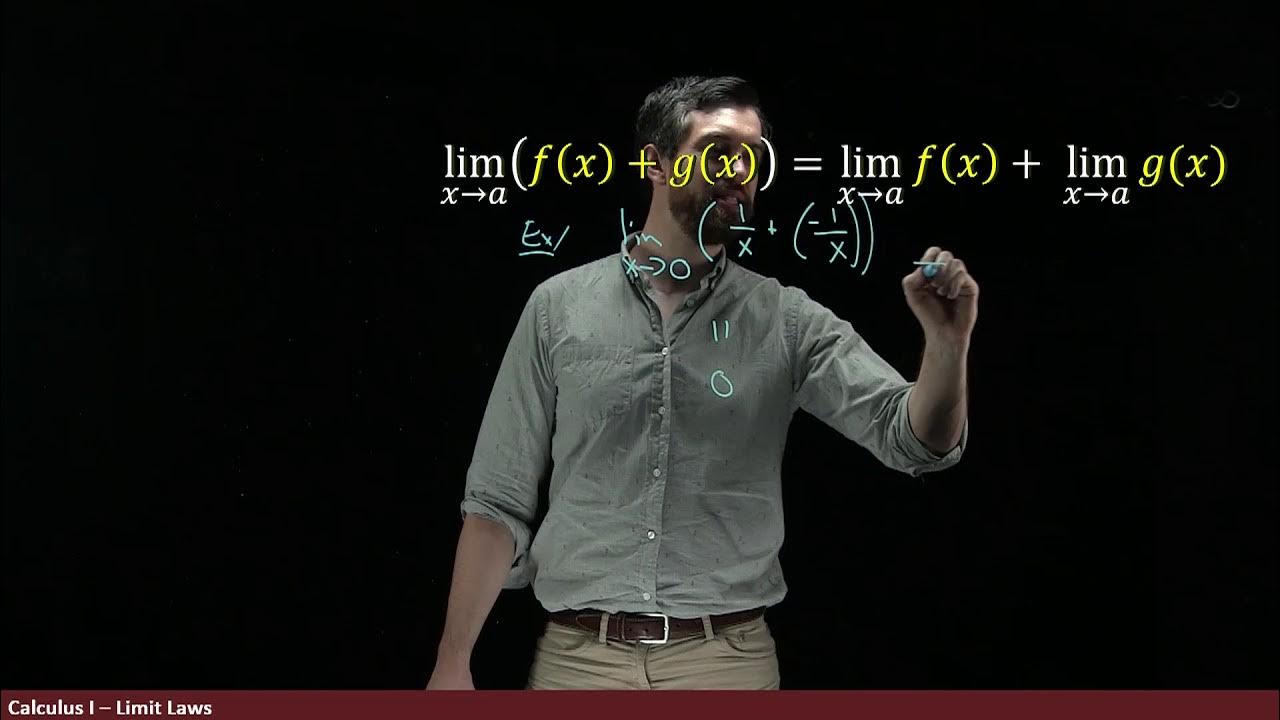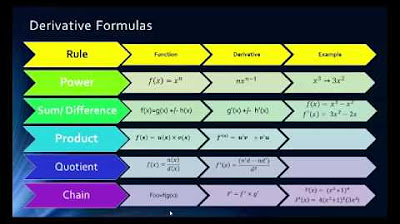BusCalc 04 Limit Rules
TLDRThis video script provides a clear explanation of the fundamental rules for calculating limits in mathematics. The presenter covers the additivity rule, which states that the limit of a sum of functions is equal to the sum of their individual limits. Similarly, the limit of a difference follows the same principle. The product rule is introduced, explaining that the limit of a product of functions is the product of their individual limits, with a special note that constants can be factored out of the limit. The quotient rule is also discussed, emphasizing that the limit of a quotient is the quotient of the limits, provided the denominator does not approach zero. Lastly, the power rule is mentioned, which allows one to take the limit of a function and then raise it to a power. The script promises that upcoming examples will illustrate these rules in practice, potentially enhancing the viewer's understanding.
Takeaways
- 📚 **Additivity Rule**: The limit of the sum of two functions is the same as the sum of their individual limits.
- 🔢 **Subtraction Rule**: The limit of the difference between two functions equals the difference of their individual limits.
- 🤝 **Product Rule**: The limit of the product of two functions is the product of their individual limits.
- 🔄 **Constant Factor Rule**: A constant can be factored out of a limit expression, simplifying the calculation.
- ⚖️ **Quotient Rule**: The limit of a quotient of two functions is the quotient of their individual limits, provided the denominator doesn't approach zero.
- ↗️ **Power Rule**: When taking the limit of a function raised to a power, first take the limit of the function and then apply the power.
- 📈 **Limit Operations**: Limits can be broken down into simpler operations (addition, subtraction, multiplication) for easier calculation.
- 🚫 **Division Caution**: When applying the quotient rule, ensure the denominator does not approach zero to avoid undefined behavior.
- 🔑 **Simplifying Limits**: The rules provided are key to simplifying complex limit expressions into more manageable parts.
- 📐 **Combining Rules**: In practice, you may need to combine these rules to solve more complex limit problems.
- 📚 **Upcoming Examples**: The next video will provide examples demonstrating the application of these limit rules in practice.
Q & A
What is the additivity rule for limits?
-The additivity rule for limits states that the limit of the sum of two functions f(x) and g(x) as x approaches a certain number is equal to the sum of the individual limits of f(x) and g(x) as x approaches the same number.
How does the additivity rule apply to the subtraction of functions?
-The additivity rule also applies to subtraction, meaning that the limit of the difference between two functions is equal to the difference of their individual limits.
What is the product rule for limits?
-The product rule for limits states that the limit of the product of two functions is equal to the product of the individual limits of each function taken separately.
Can you factor out a constant from a limit?
-Yes, if one of the functions within a limit is a constant (k), you can factor it out in front of the limit, making it easier to calculate.
What is the quotient rule for limits?
-The quotient rule for limits allows you to take the limit of the quotient of two functions, as long as the denominator does not approach zero, by taking the limit of the numerator and the denominator separately and then dividing them.
What is the power rule for limits?
-The power rule for limits states that if you have a function raised to a power (f(x)^n), you can first take the limit of the function and then raise it to the nth power.
Why is it important not to divide by zero when taking limits?
-Division by zero is undefined in mathematics, so it's crucial to ensure that the denominator of a limit does not approach zero to avoid an undefined result.
Can you apply the additivity rule to limits when the functions are complex?
-Yes, the additivity rule can be applied to complex functions as well, as long as the limits exist, allowing you to break down the limit into simpler parts.
How does breaking up a limit into separate limits help in calculations?
-Breaking up a limit into separate limits can simplify the calculation process, especially when dealing with sums, differences, products, or quotients of functions.
What is the significance of providing examples in the next video?
-Providing examples in the next video will help illustrate how to apply these limit rules in practice, making it easier for viewers to understand and apply the concepts.
Why is it easier to calculate limits after applying the product rule?
-The product rule allows you to calculate the limits of each function separately, which can be simpler than finding the limit of their product, especially when the functions are complex.
What does it mean to 'take the limit' in mathematical terms?
-To 'take the limit' refers to the process of finding the value that a function or sequence approaches as the input (often denoted as x) approaches a certain value. It's a fundamental concept in calculus.
Outlines
📘 Additivity and Subtraction Rules for Limits
The first paragraph introduces the additivity rule for limits, explaining that the limit of the sum of two functions is equal to the sum of their individual limits. This rule can simplify the process of finding limits by allowing the separation of a complex limit into two or more simpler limits. Additionally, the paragraph covers the subtraction rule, which operates similarly to the additivity rule, allowing the limit of a difference to be broken down into the difference of two limits.
Mindmap
Keywords
💡Additivity Rule
💡Product Rule
💡Quotient Rule
💡Power Rule
💡Constant Factor
💡Limit
💡Continuity
💡Derivative
💡Function
💡Calculus
💡Example Problems
Highlights
The additivity rule for limits states that the limit of a sum of functions is the same as the sum of their individual limits.
For subtraction, the limit of a difference between two functions equals the difference of their individual limits.
The product rule for limits allows breaking up the limit of a product of functions into the product of their individual limits.
If one of the functions in a product is a constant, you can move the constant outside of the limit operation.
The quotient rule for limits applies as long as the denominator does not approach zero, allowing the division to be broken up into separate limits.
The power rule for limits allows you to take the limit of a function first and then raise it to the given power.
Understanding these limit rules is crucial for simplifying complex limit calculations.
The video emphasizes the straightforward nature of these rules, making them accessible for a wider audience.
The presenter plans to demonstrate the application of these rules in the next video through several examples.
The additivity rule is fundamental for combining limits of functions as x approaches a specific number.
Subtracting functions within a limit can simplify the process of finding the limit of more complex expressions.
The product rule simplifies the process of finding limits when functions are multiplied together.
Constants can be factored out of limit operations, simplifying the calculation process.
The quotient rule is a powerful tool for finding limits of functions divided by other functions, provided the denominator doesn't approach zero.
The power rule provides a method to handle limits of functions raised to various powers.
The video aims to clarify why these limit rules are necessary for calculus and mathematical analysis.
Practical examples in the next video will help illustrate the utility of these rules in real-world calculations.
Transcripts
Browse More Related Video

Limit properties | Limits and continuity | AP Calculus AB | Khan Academy

Limit Laws | Breaking Up Complicated Limits Into Simpler Ones

Limits of combined functions: piecewise functions | AP Calculus AB | Khan Academy

Math 1325 Lecture 9 7 - Using Derivative Forumulas

Limits of combined functions | Limits and continuity | AP Calculus AB | Khan Academy

The Integral Calculus Rules — Topic 86 of Machine Learning Foundations
5.0 / 5 (0 votes)
Thanks for rating: